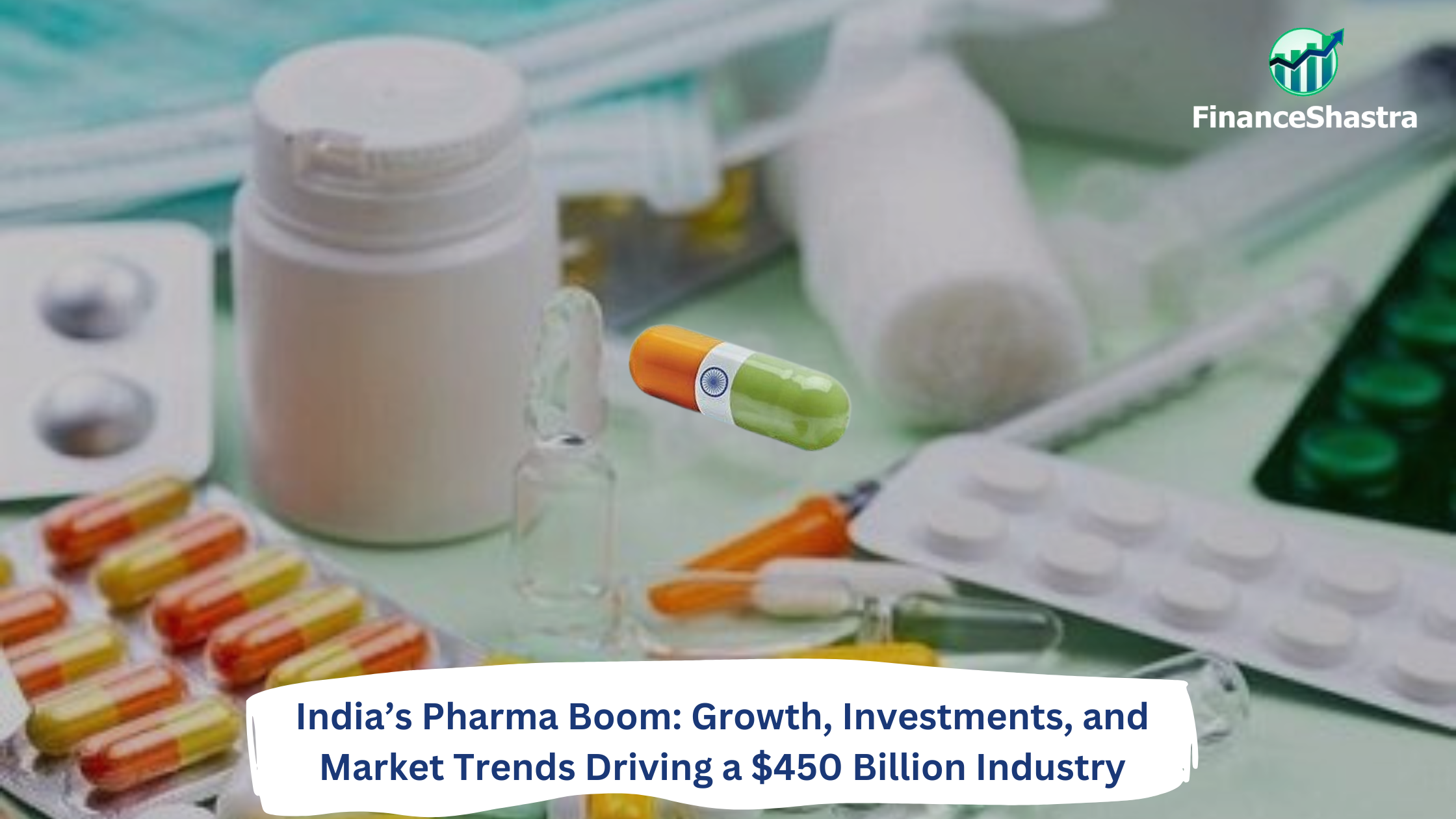India’s Pharma Boom: Growth, Investments, and Market Trends Driving a $450 Billion Industry
Overview:
India is one of the biggest medicine makers in the world. It produces low-cost, high-quality medicines and vaccines used in many countries. India is the third-largest producer of medicines by volume and has been growing at 9.43% per year for the past nine years. India supplies 50% of the world’s vaccines, 40% of generic medicines in the US, and 25% of medicines in the UK. It has 3,000 drug companies and over 10,500 factories that make medicines. India also has the most factories approved by the US FDA outside the US.
India is called the “pharmacy of the world” because it supplies 80% of global HIV/AIDS medicines. The pharma industry is expected to be worth $65 billion by 2024 and $130 billion by 2030. The government wants the industry to reach $450 billion by 2047. India makes biotech products like vaccines, biosimilars, and new treatments. The biotech industry in India was worth $137 billion in 2022 and is expected to reach $300 billion by 2030. The medical devices sector, which includes hospital machines and equipment, is also growing. It is worth $11 billion now and is expected to grow to $50 billion by 2030.
India is a big exporter of medicines. It earns $50 billion from the pharma industry, with $25 billion coming from exports. About 20% of the world’s generic drug exports come from India. The pharma market grew by 5% in 2023 and is expected to grow by 9-11% in 2024. The pharma industry employs millions of people and is growing fast. With more research, better technology, and new investments, India will continue to provide affordable medicines to the world and remain a global leader in healthcare.
The government is making major improvements in healthcare, education, and taxation. Over the next three years, every district hospital will get a Day Care Cancer Centre, with 200 opening in 2025-26. Medical colleges will add 10,000 seats next year and 75,000 in five years. Research students in IITs and IISc will get better financial support through 10,000 fellowships. Medical tourism will expand with easier visa rules and private partnerships. INR 20,000 crore will support private-sector research, and more funds will go to the ‘Saksham Anganwadi and Poshan 2.0’ program for better nutrition. Foreign investment in insurance is now fully allowed, boosting the healthcare sector.
Taxes will become simpler with a new Income Tax Bill. Startups registered before March 2030 get three years of tax-free profits. Merging companies can use past losses for up to eight years. Tax return updates are now allowed for four years, with extra charges after two years. Tax collection (TCS) on goods sales will be removed, but tax deduction (TDS) on purchases will remain. The TCS limit for foreign remittances is now INR 10 lakh. Small charitable trusts get easier tax rules, and online tax appeals will continue.
These changes will improve healthcare access, support education, boost businesses, and simplify taxes.
Latest Stock News:
The Nifty Pharma index went up by 0.25% even though the overall market was weak, reaching 20,435.7. Some of the top-performing pharma stocks were Natco Pharma (up 2.52%), Glenmark Pharmaceuticals (up 1.95%), Laurus Labs (up 1.73%), Granules India (up 1.56%), and Dr. Reddy’s Laboratories (up 1.22%). On the other hand, some companies saw a drop in their stock prices, including J B Chemicals & Pharmaceuticals (down 1.8%), Mankind Pharma (down 1.36%), Gland Pharma (down 1.26%), Abbott India (down 0.48%), and Aurobindo Pharma (down 0.37%).
Potentials:
The pharma industry has a lot of room to grow because more people need healthcare, and the government is supporting it. More medical colleges are opening, new cancer treatment centers are being set up, and India is promoting itself as a medical tourism hub. Foreign companies can now invest more in insurance, which will also help healthcare grow. The government is also giving ₹20,000 crore to encourage research and new medical discoveries. Since India is a big supplier of medicines worldwide, companies have a chance to expand their business. Overall, the demand for medicines and healthcare services will keep increasing, making this industry a good place for future growth.
India’s pharmaceutical industry is growing fast. Right now, it is worth about $58 billion, but it is expected to double by 2030 and could reach up to $450 billion by 2047. This growth is happening because more people are dealing with health issues like diabetes and heart disease, the population is getting older, and there is a greater focus on overall health.
India also allows foreign companies to invest easily in the pharma sector, making it an attractive place for global investors. The country is the third-largest producer of medicines in the world and the biggest supplier of generic (low-cost) medicines, providing 20% of the world’s supply. With over 3,000 pharma companies and 10,000 factories, India is a major player in the global healthcare market.
The Nifty Pharma Index, which tracks the performance of India’s top 20 pharmaceutical companies listed on the NSE, closed at ₹20,390 on February 24, with a marginal gain of 0.02%.
Analyst Insights:
Key Metrics:
Market Capitalization: ₹15.69 lakh crore
52-Week High/Low: ₹23,908 / ₹17,905
Price-to-Earnings (P/E) Ratio: 31.4
Price-to-Book Value: 5.08
Dividend Yield: 0.67%
Growth Over Time:
Last 1 Year: Grew by 7.00%
Last 5 Years: Grew by 20.8% per year on average
Last 10 Years: Grew by 5.97% per year on average
The pharma sector has grown well in the long run due to rising demand for medicines, healthcare investments, and India’s strong position in generic drug production. However, stock prices are high, so investors should carefully choose where to invest.

